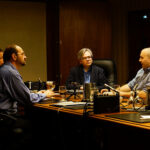|
|
This Presentation date is May 2, 2012 at 13:00-15:00.
Presenters: Chip Copper, Greg Ferro, Stephen Foskett
Part 1: What is an Ethernet Fabric?
Watch on YouTube
Watch on Vimeo
Part 1 of the Virtual Symposium focuses on Ethernet fabrics:
- Historical Ethernet LAN design: The 3-layer Hierarchy with Spanning Tree
- The demand for fabric technology, from Ethernet to Fibre Channel
- Core-Edge Ethernet Fabric Architecture
- The design of Ethernet and Fibre Channel switches
- Brocade’s VCS technology: Auto-healing and improved utilization
- Virtual machine-aware network automation (port profiles and vCenter)
- The Brocade VDX product family
Join Chip Copper of Brocade and the following Tech Field Day delegates as they discuss this question.
The Tech Field Day discussion, recorded on May 2, 2012, delves into the concept of Ethernet fabrics, exploring their historical context, current applications, and future potential. The session, led by Stephen Foskett and featuring experts like Brandon Carroll, Chip Copper, Greg Ferro, Ethan Banks, and Ivan Pepelnjak, begins with an overview of traditional Ethernet LAN design, which has long relied on a three-layer hierarchy with Spanning Tree Protocol (STP). This design, rooted in constraints from the 1970s, has persisted despite its limitations, such as the need to avoid network loops and the inefficiencies of STP. The discussion highlights how these legacy designs have shaped current networking practices, often leading to rigid and suboptimal network architectures.
Chip Copper from Brocade introduces the concept of Ethernet fabrics as a more flexible and efficient alternative to traditional hierarchical designs. He explains that Ethernet fabrics have been around for about 15 years, offering a more dynamic and resilient network structure. Unlike the old model, which places cheap, less capable devices at the edge and more expensive, powerful devices at the core, Ethernet fabrics allow for a more distributed and intelligent network. This approach eliminates the need for Spanning Tree Protocol by enabling direct communication between nodes, thus avoiding the artificial constraints imposed by traditional designs. Copper emphasizes that this shift is not just about improving performance but also about simplifying network management and reducing the need for extensive manual configurations.
The presentation also touches on the practical applications of Ethernet fabrics in modern data centers, particularly in the context of virtual machine (VM) management. Copper discusses Brocade’s VCS technology, which supports features like auto-healing and improved utilization, making the network more resilient and efficient. He highlights the importance of network automation, particularly in environments with high VM mobility, where traditional network configurations can become a bottleneck. By integrating with tools like VMware’s vCenter, Brocade’s solutions can automatically adjust network settings based on VM movements, ensuring consistent performance and security without manual intervention. This capability not only enhances operational efficiency but also aligns network behavior more closely with business needs, ultimately supporting more agile and responsive IT environments.
Personnel: Brandon Carroll, Chip Copper, Ethan Banks, Greg Ferro, Ivan Pepelnjak, Stephen Foskett
Part 2: Converged Networking and Storage
Watch on YouTube
Watch on Vimeo
Part 2 of the Virtual Symposium turns to the topic of convergence. The delegates discuss the core questions of convergence:
- What’s stopping convergence and what’s driving it?
- Who owns responsibility organizationally?
- What protocols (Fibre Channel, FCoE, iSCSI, or even NFS) “count”?
- Contrasting the financial benefits with the management complexity.
- A discussion of other protocols (especially iSCSI) over lossless-Ethernet (DCB)
- Comparison of buffer credit mechanisms (as in Fibre Channel) with pause mechanisms (in DCB Ethernet)
- Demands on Ethernet hardware design to support converged traffic (less over-subscription, larger buffers, etc)
- The heavy demands placed by solid state storage on storage networks
- The role of Ethernet fabrics in converged networks
- The challenge of ETS (802.1Qaz) and DCBX for storage vendors
- Considering the difficulty of implementing congestion notification (802.1Qau) in network hardware
Join Chip Copper of Brocade and the following Tech Field Day delegates as they discuss this question.
Personnel: Chip Copper, Josh O'Brien, Stephen Foskett, Tony Bourke
Part 3: Multi-Path vs. Multi-Chassis
Watch on YouTube
Watch on Vimeo
Join a panel of networking heavyweights as they discuss multi-chassis architecture such (Brocade VCS) and contrast it to multi-pathing technology (TRILL). The discussion touches on the following points:
- How TRILL fabrics do multi-path and where it really works
- What link-state routing protocol to use (Routing Bridges, IS-IS, FSPF)
- Is interoperability and standardization (Fabric Path, VCS) a red herring?
- An extensive whiteboard demonstration of load balancing across multiple links with aggregation groups – traditional Ethernet LACP/Port Channels per-flow vs. Brocade per-frame link aggregation
- Further whiteboard discussion of scalability and standards-compliance of multi-chassis technology
Personnel: Chip Copper, Chris Marget, Greg Ferro, Ivan Pepelnjak, Josh O'Brien, Tony Bourke
Part 4: Hard Cores and Soft Edges
Watch on YouTube
Watch on Vimeo
Ivan Pepelnjak leads a discussion of virtual machine networking and tenant isolation. The panel discusses the following issues:
- Virtual “soft switch” capability
- Cisco UCS VM-FEX and Arista EOS VM Tracer
- Brocade Automated Migration of Port Profiles (AMPP)
- Security implications of flexible network automation
- Does a virtual chassis concept address the challenges of dynamic virtual infrastructure?
- Convergence of networking and storage
- Long-distance virtual machine motion
Personnel: Chip Copper, Derick Winkworth, Greg Ferro, Ivan Pepelnjak, Tom Hollingsworth, Tony Bourke









